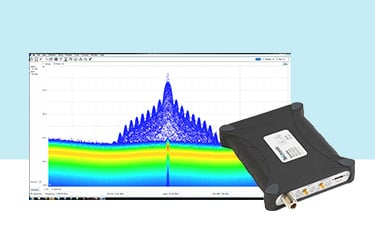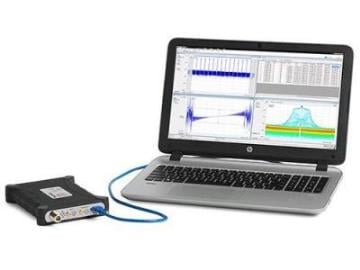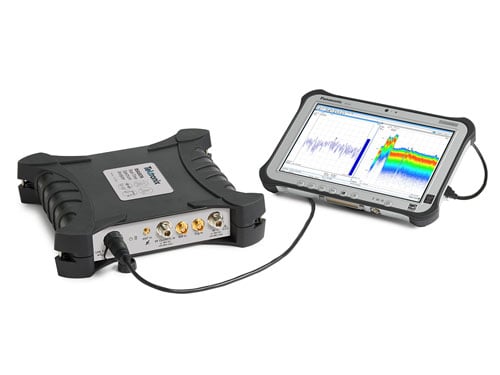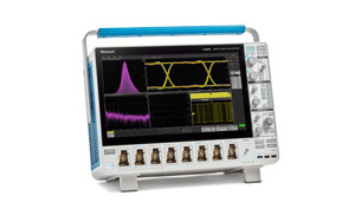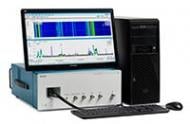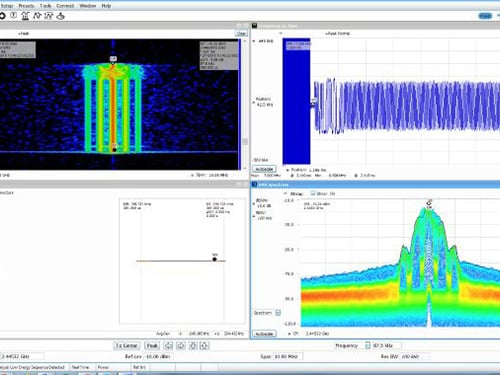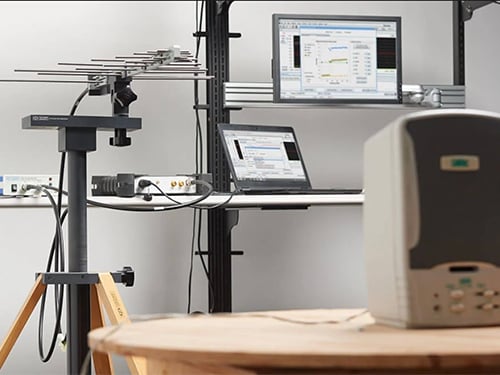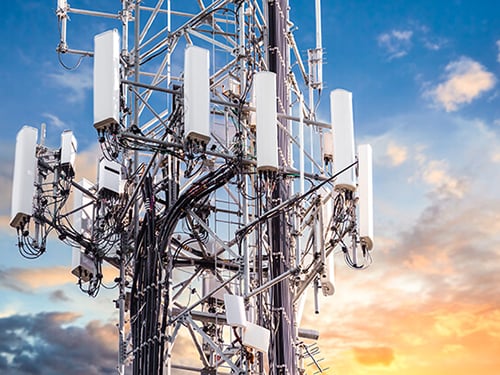Kontaktaufnahme
Live-Chat mit Tektronix-Vertretern. Verfügbar von 9 bis 17 Uhr CET Geschäftstage.
Kontaktieren Sie uns telefonisch unter
Verfügbar von 9 bis 17 Uhr CET Geschäftstage.
Download
Laden Sie Handbücher, Datenblätter, Software und vieles mehr herunter:
Feedback
Das Verständnis von Hochfrequenztests: Der Schlüssel zum Erfolg drahtloser Systeme
Bei der HF-Prüfung werden die elektromagnetischen Wellen gemessen und analysiert, die zur Übertragung von Signalen in einer Vielzahl von Anwendungen verwendet werden – von der drahtlosen Kommunikation und dem Rundfunk bis hin zu Radar- und Satellitensystemen. Bei HF-Tests werden Leistung, Stärke und Qualität dieser Signale bewertet, um sicherzustellen, dass sie bestimmte Standards und Anforderungen erfüllen. Dies ist für die Entwicklung, Validierung und Wartung von HF-Komponenten und -Systemen von entscheidender Bedeutung, da es dabei hilft, alle Probleme zu erkennen, die die Funktionalität und Zuverlässigkeit von drahtlosen Kommunikations- und Sensorsystemen beeinträchtigen könnten. Darüber hinaus gewährleisten HF-Tests die elektromagnetische Verträglichkeit (EMV) – sie decken sowohl Emissionen als auch Störfestigkeit ab –, die für die Vermeidung von Störungen und die Gewährleistung eines reibungslosen Betriebs elektronischer Geräte in ihrer Umgebung von entscheidender Bedeutung sind.
Erfahren Sie, wie es geht:
Was ist ein HF-Test?
HF-Tests sind von entscheidender Bedeutung, um die optimale Leistung und Zuverlässigkeit von drahtlosen Kommunikationssystemen und elektronischen Geräten sicherzustellen. Durch die Durchführung umfassender HF-Tests können Ingenieure Probleme im Zusammenhang mit der Signalintegrität, Interferenzen und der Effizienz des Gesamtsystems erkennen und beheben. Dies verbessert nicht nur die Qualität und Funktionalität von Funkkomponenten und -systemen, sondern gewährleistet auch die Einhaltung von Industrienormen und gesetzlichen Vorschriften. Effektive HF-Tests minimieren das Risiko kostspieliger Ausfälle, maximieren die Betriebseffizienz und bieten die Gewissheit, dass die Drahtlos-Technologie unter realen Bedingungen die erwartete Leistung erbringt. Letztendlich sind HF-Tests von entscheidender Bedeutung für die Entwicklung, Zertifizierung und Wartung von Geräten, die auf Funkfrequenzen angewiesen sind – von alltäglicher Unterhaltungselektronik bis hin zu spezialisierter Industrieausrüstung – und helfen Unternehmen, in der heutigen hypervernetzten Welt einen Wettbewerbsvorteil zu erlangen.
Frequenz (Spektrum) vs. Zeitbereichsanalyse
Das Verständnis der Unterschiede und Gemeinsamkeiten zwischen der Frequenz- (Spektrum) und der Zeitbereichsanalyse ist für eine effektive Prüfung der Hochfrequenz (HF) entscheidend. Jeder Bereich bietet einzigartige Einblicke und wird verwendet, um die ordnungsgemäße Funktion der drahtlosen Kommunikation innerhalb regulierter Frequenzzuweisungen zu optimieren und sicherzustellen.
Frequenz (Spektrum) Domänenanalyse
Definition: Die Frequenzanalyse (Spektrumsanalyse) ist der Prozess der Bewertung des Frequenzspektrums elektromagnetischer Signale, um ihre Eigenschaften wie Amplitude, Frequenz und Phase zu identifizieren und zu messen. Mit einem Spektrumanalysator können Ingenieure Probleme wie Signalinterferenzen, Störsignale und Oberschwingungen erkennen und diagnostizieren. Die Spektrumanalyse ermöglicht die präzise Identifizierung verschiedener Signalquellen innerhalb einer gegebenen Bandbreite und stellt sicher, dass die Systeme effizient und ohne unerwünschte Störungen arbeiten. Es ist ein grundlegendes Werkzeug für die Entwicklung, Prüfung und Wartung von drahtlosen Kommunikationssystemen, Rundfunkgeräten, Radar und anderen HF-Anwendungen.
Anwendungsfälle: Die Spektrumanalyse ist in verschiedenen Branchen von entscheidender Bedeutung, darunter Mobilfunknetze und drahtlose Kommunikation, Rundfunk, Radar und Verteidigung, Luft- und Raumfahrt, medizinische Geräte, Forschung und Entwicklung, Konformitätstests und industrielle Anwendungen, da das elektromagnetische Spektrum von verschiedenen Organisationen wie der ITU, FCC und der EU stark reguliert wird. Sie stellt sicher, dass die Geräte diese Vorschriften einhalten, hilft bei der effizienten Verwaltung des Spektrums und identifiziert Störquellen.
Herausforderungen und Lösungen: Die Frequenzanalyse steht vor mehreren wichtigen Herausforderungen, darunter die Verwaltung immer stärker frequentierter Frequenzbänder, die Identifizierung und Minderung von Signalstörungen sowie die Gewährleistung genauer Messungen in komplexen Umgebungen. Ingenieure müssen sich auch mit der raschen Entwicklung der Drahtlostechnologien befassen, die eine ständige Aktualisierung der Prüfmethoden und -geräte erfordert. Darüber hinaus ist die Einhaltung strenger gesetzlicher Vorschriften bei gleichzeitiger Optimierung der Signalleistung eine weitere komplexe Aufgabe. Diese Herausforderungen erfordern fortschrittliche Geräte und Software, um einen zuverlässigen und effizienten Betrieb des HF-Systems zu gewährleisten.
Zeitbereichsanalyse
Definition: Die Zeitbereichsanalyse untersucht, wie sich HF-Signale im Laufe der Zeit verhalten, und konzentriert sich dabei auf die Änderungen in Phase, Amplitude und Frequenz. Sie bietet Einblicke in die dynamischen Eigenschaften des Signals.
Anwendungsfälle: Die Zeitbereichsanalyse von HF-Signalen bietet mehrere wichtige Vorteile, darunter die Möglichkeit, vorübergehende Ereignisse und nicht wiederkehrendes Signalverhalten in Echtzeit zu erfassen und zu analysieren. Diese Methode bietet detaillierte Einblicke in Signalamplitude, Phase und Zeiteigenschaften und ermöglicht so eine präzise Fehlersuche und Optimierung von HF-Systemen. Die Zeitbereichsanalyse ist besonders effektiv, um Probleme mit schnell ansteigenden Flanken, gepulsten Signalen, Phasenregelkreisen, Frequenzeinschwingungen und Synchronisationsproblemen zu erkennen.
Herausforderungen und Lösungen: Die größte Herausforderung im Zeitbereich ist die genaue Charakterisierung sich schnell ändernder Signale, die bei fortschrittlichen Kommunikationssystemen und Radartechnologien von entscheidender Bedeutung sind. Die Zeitbereichsanalyse mit hoher Bandbreite kann hier Abhilfe schaffen, indem sie selbst kleine zeitliche Veränderungen genau erfasst und mit dem Verhalten des Signals im Frequenzbereich korreliert.
Wichtige Werkzeuge und Systeme für Hochfrequenztests (HF-Tests)
HF-Tests sind entscheidend für die Gewährleistung der Leistung und Effizienz von drahtlosen Kommunikations- und Sensorgeräten. Hier konzentrieren wir uns auf die wesentlichen Werkzeuge, die bei HF-Tests verwendet werden. Dazu gehören Echtzeit-Spektrumanalysatoren, Oszilloskope und Arbiträrgeneratoren, die jeweils eine einzigartige Rolle im Testprozess spielen.
Hardware und Systeme für die Hochfrequenzprüfung
Echtzeit-Spektrumanalysatoren (RSA)
Wichtige Leistungsmerkmale:
- Hochgeschwindigkeitsleistung: RSAs wurden für die schnelle, lückenlose Erfassung und Analyse von HF-Signalen mit hoher Bandbreite entwickelt.
- Echtzeitfunktionen: Anders als herkömmliche Spektrumanalysatoren verarbeiten RSAs Signale innerhalb ihrer momentanen Bandbreite in Echtzeit und können so vorübergehende Ereignisse erfassen, die anderen Geräten möglicherweise entgehen. Sie ermöglichen eine gründliche Analyse komplexer Kommunikations- und Radarsignale.
Anwendungen: RSAs sind unverzichtbar in Umgebungen, in denen Geschwindigkeit und Genauigkeit entscheidend sind, z. B. beim Testen dynamischer drahtloser Signale und komplexer Störszenarien.
Typische Einsatzorte:
- Laboreinstellungen: RSAs werden häufig in F&E-Labors für die Entwicklung neuer Komponenten und Systeme für drahtlose Technologien eingesetzt, wo die Echtzeitanalyse entscheidend für die Erkennung von schnell bewegenden Anomalien und Störsignalen ist.
- Fertigungseinrichtungen (Fab): Bei der Fertigungsprüfung stellen RSAs sicher, dass die Produkte die erforderlichen HF- und Emissionsspezifikationen erfüllen, und können dabei helfen, ihre HF-Leistung zu kalibrieren, bevor sie den Endverbraucher erreichen.
- Feldtests: Ingenieure verwenden tragbare RSAs zur Vor-Ort-Diagnose, Fehlerbehebung und Systemvalidierung im Feld, insbesondere in den Bereichen Radar, Telekommunikation und Rundfunk.
Oszilloskope
Wichtige Leistungsmerkmale:
- Vielseitige Bandbreitenoptionen: Von einigen MHz bis zu mehreren GHz momentaner Bandbreite.
- Mehrkanal-Modelle: Erhältlich in 2-, 4- und bis zu 8-Kanal-Konfigurationen, die die Fähigkeit zur gleichzeitigen Überwachung mehrerer Signale verbessern.
Anwendungen: Oszilloskope sind entscheidend für die detaillierte Analyse der Zeitbereichseigenschaften elektronischer Signale und besonders nützlich in Forschungs- und Entwicklungsumgebungen zum Debuggen und zur Überprüfung der Signalintegrität.
Typische Einsatzorte:
- Laboreinstellungen: Unverzichtbar für Forschung, Entwicklung und Validierung des Zeitverhaltens elektronischer Signale.
- Fertigungseinrichtungen (Fab): Werden eingesetzt, um sicherzustellen, dass elektronische Designs und Systeme während der Produktion enge Zeitstandards einhalten.
- Feldtests: Tragbare Modelle werden eingesetzt, um Probleme in realen Betriebsumgebungen zu diagnostizieren und zu beheben, z. B. an Standorten von Kommunikationsinfrastrukturen.
Oszilloskope von Tektronix ansehen
Arbiträrgeneratoren (AWG)
Wichtige Leistungsmerkmale:
- Flexibilität: AWGs bieten unübertroffene Möglichkeiten zur Erzeugung beliebiger Wellenformen, die auf spezifische Prüfbedingungen zugeschnitten sind, entweder einmalig oder als sich wiederholendes Signal.
Anwendungen: AWGs sind besonders wertvoll bei der Simulation komplexer Wellenformen und beim Testen von Gerätereaktionen unter verschiedenen Signalbedingungen und unterstützen die Entwicklung robuster und effizienter drahtloser Geräte.
Typische Einsatzorte:
- Laboreinstellungen: Wird häufig in den Entwurfs- und Prüfphasen verwendet, um verschiedene Signalszenarien zu simulieren und zu analysieren.
- Fertigungseinrichtungen (Fab): Entscheidend für die Validierung der Funktionen des Endprodukts und Belastungstests unter realistischen Bedingungen.
- Feldtests: Nützlich für die Vor-Ort-Generierung spezifischer Signale, die zum Testen von Systemreaktionen in einer realen Umgebung erforderlich sind.
Übersicht über die HF-Prüfsoftware
Software spielt bei HF-Tests eine entscheidende Rolle, da sie die Funktionalität der Hardware durch erweiterte Signalverarbeitungs-, Analyse- und Simulationsfunktionen verbessert.
Wichtige Leistungsmerkmale:
- Signalanalyse: Software-Tools liefern umfangreiche Analyseergebnisse, die den Ingenieuren helfen, die Nutzung des Spektrums, die Qualität der Signalmodulation, die Systemstabilität und die Leistung zu verstehen.
- Simulationsfunktionen: HF-Prüfsoftware kann komplexe drahtlose Umgebungen und Signalinteraktionen simulieren, sodass Ingenieure vorhersagen können, wie Geräte in realen Szenarien funktionieren.
- Automatisiertes Testen: Viele HF-Prüfsoftwarepakete enthalten Automatisierungsfunktionen, die den Prüfprozess rationalisieren, menschliche Fehler reduzieren und die Wiederholbarkeit und Effizienz erhöhen.
- Datenverwaltung: Effektive Software hilft beim Organisieren, Speichern und Abrufen von Prüfdaten und ermöglicht so eine einfachere Berichterstattung und Nachverfolgung der Einhaltung von Vorschriften.
Anwendungsgebiete:
- Designvalidierung: In der Entwicklungsphase wird umfassend Software verwendet, um alle wichtigen HF-Parameter eines Funksystems zu charakterisieren, seine Anwendungsfälle zu validieren und die elektromagnetische Verträglichkeit und Signalintegrität von Funkgeräten sicherzustellen.
- Einhaltung gesetzlicher Vorschriften: Stellt durch sorgfältige Kalibrierungs- und Prüfverfahren sicher, dass alle drahtlosen Geräte die globalen Kommunikationsstandards und -vorschriften erfüllen.
- Optimierung der Leistung: Hilft bei der Abstimmung von Geräten für eine optimale HF-Leistung unter verschiedenen Bedingungen, indem es detailliertes Feedback zum Geräteverhalten unter verschiedenen Betriebsparametern liefert.
Zubehör und Adapter für HF-Tests
Zubehör und Adapter sind unverzichtbar, um die Fähigkeiten von HF-Prüfgeräten zu erweitern und genaue und effiziente Messungen und Analysen zu gewährleisten.
Wichtige Leistungsmerkmale:
- Kabel und Anschlüsse: Hochwertige Kabel und Anschlüsse sind für die Aufrechterhaltung der Signalintegrität während der Prüfungen unerlässlich. Sie müssen an die Impedanz des Systems angepasst sein, um Reflexionen und Verluste zu vermeiden.
- Signaldämpfungselemente: Diese werden verwendet, um die Leistung eines Signals zu reduzieren, ohne seine Wellenform wesentlich zu verzerren. Dämpfungselemente sind entscheidend, um empfindliche Geräte vor hohen Signalpegeln zu schützen.
- Antennen: Für unterschiedliche Prüfungen sind möglicherweise unterschiedliche Antennentypen erforderlich, um Signale präzise zu erfassen oder zu senden. Antennen müssen auf Grundlage der für die Prüfung erforderlichen spezifischen Frequenz und des Strahlungsmusters ausgewählt werden.
- Adapter: Diese helfen dabei, verschiedene Arten von Steckern und Kabeln zu verbinden und gewährleisten die Kompatibilität zwischen verschiedenen Prüfgeräten.
- Kalibrierungskits: Eine regelmäßige Kalibrierung mit entsprechenden Kalibrierungskits ist erforderlich, um sicherzustellen, dass die HF-Testgeräte genaue und konsistente Ergebnisse liefern.
Anwendungsgebiete:
- Erweiterter Prüfbereich: Zubehör wie Antennen mit hoher Verstärkung und Breitbandkabel ermöglichen Prüfungen unter vielen Bedingungen und Konfigurationen.
- Signalcharakterisierung: Die Verwendung der richtigen Adapter und Kabel stellt sicher, dass das Signal während der Prüfung nicht verändert wird, was zu einer genaueren Charakterisierung führt.
- Gerätekompatibilität: Adapter und Kalibrierungskits tragen dazu bei, die Vielseitigkeit von Prüfgeräten aufrechtzuerhalten, sodass sie mit einer Vielzahl von Geräten und Standards kompatibel sind.



